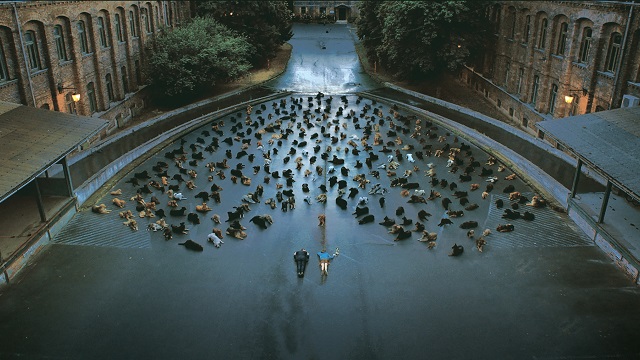James St. James opens Party Monster by saying “I think it’s so important to begin with a bang, don’t you?” Party Monster opens with a murder that isn’t revealed until almost the end of the movie, simultaneously creating the tension of expectation and giving the movie a purpose. Following in those footsteps, White God opens with the surreal image of 13-year-old Lili biking through an abandoned Budapest, followed by an immense pack of dogs. It kicks the movie off with a bang, asking us to remember the eventual street dog uprising while watching Hagen go to Hell and back.
At the age of 13, Lili is a teenager on the verge of womanhood. Just finishing her tween years, Lili is still struggling with being seen as a child by her parents and guardians who are reluctant to let her grow up. This tension is exacerbated by her parents using her as a football in an acrimonious divorce. At the beginning of the movie, her mother unceremoniously drops Lili and her dog, Hagen, off to live with her reluctant still-single father, Daniel, in his small city flat. Due to new Hungarian laws to control a rampant street dog population, any dog who isn’t a papered purebred is subject to special taxes. Reluctant to pay his ex-wife’s taxes, Daniel forces Lili to ditch Hagen by the side of the road, launching two different stories.
Lili’s story is of her rebelling against Daniel’s understandable but oppressive parenting style in order to be recognized as an adult. Like any teenager, she constantly puts herself in increasingly rebellious positions, spitting vitriol at anybody who tries to control her. Lili befriends older students in her school’s band, following them to clubs and parties, in an attempt to be seen as a mature teenager by somebody. Even if this story sounds familiar, this half of the movie is told with a refreshing honesty, directly drawing lines between Lili’s rebellion and her feeling of oppression.
But, where the movie comes alive is in Hagen’s story. After being dumped on the side of the road, Hagen fights for survival before going through a series of trials that eventually lead to him leading a rebellion of the hundreds of street mutts waiting for either adoption or death at the pound. Hagen’s story is a series of genre experiments. Fighting for survival, Hagen befriends a Jack Russell Terrier before being caught and taught to fight, leading to his seeking of revenge for all the wrongs inflicted upon him and his people. Yes, Hagen’s story is Gladiator for dogs. In order to craft this as a genre experiment, director Kornél Mundruczó pulls from a number of identifiable scenes, ranging from Les Miserables to They Live. By recreating familiar scenes with dogs, without making the scenes “cute,” Mundruczó finds new depth through the increased innocence associated with animals.
The intent behind Hagen’s story is to explore the relationship of oppression and rebellion, asking us to extend these metaphorical stories to minority underclasses. His challenge is that the underclass is constantly manipulated by the largely white middle and upper classes – hence the title: White God – and any rebellion exhibited by these groups is understandable and justified. Hagen’s rebellion dovetails with Lili’s rebellion, providing a mildly heavy handed statement about the sympathetic purpose of an uprising and forging your own path.
Unfortunately, these themes are underdeveloped and overshadowed by all of the genre exercises that fill Hagen’s story. Watching Hagen’s story, the thrill comes from the freshness added to familiar scenes. Secondary is the directorial wizardry that comes from directing animals through familiar beats without making them a joke. Add to this the visual intensity of hundreds of dogs running through the streets of an abandoned Budapest while going through the second half of a revenge horror movie, and White God becomes a visual and emotional treat.

